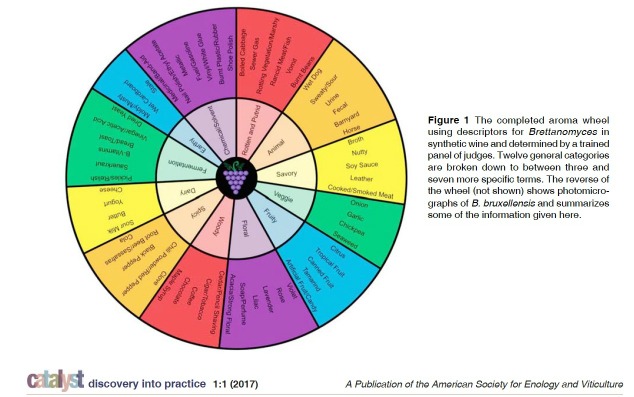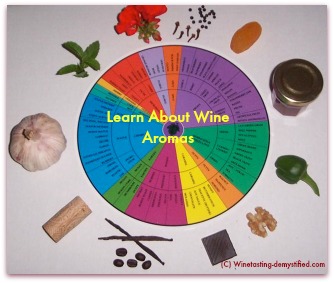| Back to Back Issues Page |
 |
|
Wine Funky Smells and Other Weird Science News | Wine Tasting Tips #15 May 15, 2019 |
Issue #15Wine Funky Smells and Other Weird Tasting Science NewsHappy Month of May! I am quite happy this first quarter is over and to finally get back to my favorite weekend activity, writing to you about wine tasting. Long story short, I had to take care of family matters back in France and some challenging projects at work. That’s why I haven’t kept on my promise to deliver a monthly newsletter in your inbox and I apologize. In this issue of Wine Tasting Tips, you will discover: * The two animals you don’t want to smell in your wine * Physics principles of wine tears * Why you may also smell with your tongue * My 3 Wine Tasting Tips
The two animals you don’t want to smell in your wineHORSEAn article in the San Francisco Chronicle caught my eye with this title “Did Mandy Heldt Donovan just ruin her wine? Why the Napa winemaker intentionally added brettanomyces — a spoilage yeast — to her Pinot Gris”. Hmm…, Brettanomyces bruxellensis is a yeast that usually winemakers do their best to avoid and are very paranoid about getting close to their winery. Indeed, aromas of manure, Band-Aid, horse sweat are not particularly pleasant to smell in wine. The winemaker explains she was curious to learn if she could use this yeast as a winemaking tool, especially since it is quite popular in craft beer making.The story goes on to reveal that Donovan was a student of Dr Linda Bisson, a renown yeast geneticist from the University of California, Davis. This work originated from anecdotal evidence that Brett sometimes imparted pleasant floral notes in wine. So Linda and her colleagues characterized the aroma compounds produced by 99 yeast isolates. They found that all strains produced the two culprit compounds 4-ethyl phenol (4EP) and 4-ethyl guaiacol (4EG), under low oxygen conditions (like in a wine barrel) feeding on two amino acids called cinnamic acids. However, when feeding on other substates, different compounds were produced, and in total the scientists identified 44 compounds imparting a diverse spectrum of aromas. 
The full text is available on researchgate.net If you are inclined to go deeper on this topic, I recommend reading this article “Two Decades of “Horse Sweat” Taint and Brettanomyces Yeasts in Wine: Where do We Stand Now?”. It not only covers the origin of the taint, but also some remediation techniques. All article references are available at the end of this newsletter. MOUSEOne off-flavor that is difficult to get tasters to describe in consensus is Mousey. It is also caused by Brettanomyces yeasts as well as other yeasts. I remember when working at a winery, one of the senior executive was very sensitive to this taint and was annoyed when few of us could not detect it. He had this weird habit when he was suspicious of such a taint: he would put his palm on the glass rim, shake the glass from top to bottom and then smell the wine on his palm and confirm or not the presence of the taint. Why is that? The “glass-palm” method is one way of minimizing variability among panelists. A recent group of sensory scientists tested other protocols and found better results only when the wine pH was adjusted to 5, which is difficult to do without a wine lab handy (Tempere et coll. 2019). Have you heard about Oenodynamics?This is the science studying liquid movements in a wine glass during wine tasting. Actually I found out that a Swiss laboratory is specialized in oenodynamics, where scientists study academically movements occurring in your wine glass. Fascinating!Why mentioning Oenodynamics? I stumbled upon this article asking: “Why is your wine crying? Scientists say shock waves likely play a role”. The story is about R. Andrea Bertozzia, an UCLA mathematician, intrigued by the dynamics of the wine tears formation. Check out a video demonstrating how wine tears are formed.
Other Wine Tasting Science NewsHumans may smell with their tongues. Researchers at the Monell Chemical Senses Center have discovered working olfactory receptors in the taste-sensing cells on the papillae of the tongue. While this remains to be proven, these cells may communicate aroma sensations to the brain.
My 3 Wine Tasting Tips#1:Brett Taint is more than Barnyard Smell Researchers have hound more than 40 descriptors to describe the aromas produced by Brettanomyces yeasts. Use the Brett Wine Aroma Wheel for reference.#2: Shaking your Wine Glass Top to Bottom may Reveal a Mousey Taint #3: Always Swirl your Wine Glass before Smelling and Tasting the wine Not only will you free the wine aromas and be able to detect them but you will be able to observe the dynamic formation of wine tears. References used in this issueCreation and Use of a Brettanomyces Aroma WheelTwo Decades of “Horse Sweat” Taint and Brettanomyces Yeasts in Wine: Where do We Stand Now? Comparison between standardized sensory methods used to evaluate the mousy off-flavor in red wine. Why is your wine crying? Scientists say shock waves likely play a role Swirling your wine is not pretentious; it’s just good physics Humans smell with their tongues
Share the Love and Stay in TouchThank you for your time.If you liked this issue of Wine Tasting Tips, don't forget to forward it to your friends, family and colleagues. If a friend DID forward this to you and if you like what you read, don't spare a minute and Subscribe Today Comments? Ideas? Feedback? I'd love to hear from you. Just reply to this e-zine and tell me what you think! or E-mail me and share your thoughts Are you on social media? Find me on Facebook and Twitter.Cheers! Isabelle |
| Back to Back Issues Page |

